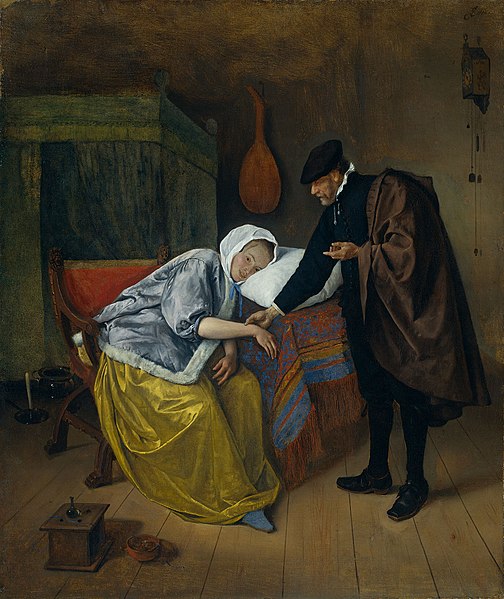 |
| A typical SP encounter. [Doctor and His Patient, via wikimedia] |
This blog is mostly written about and for people who have experience with Standardized Patient work already. But new SP opportunities occur all the time. And the more I work, the more I see how much is taken for granted within each SP program. So in the interest of expectations management, I think it's always good to provide an overview.
Standardized Patients pretend to be patients so that students can pretend to be doctors. Slate has a good article that introduces the general concept in its article "Playing Doctor." I've also written a brief post about the history of SPs in medical education.
Good SPs are valued for their abilities to memorize details, perform realistically, maintain consistency and improvise appropriately -- all while keeping half a mind open to analyze the scenario as it unfolds. They also take direction well to fit the needs of the organization.
When organizations try to use SPs who are known to the students (like fellow students, faculty members or staff), students have a hard time negotiating their social roles in the context of the event. However, if professional SPs are used in roleplaying scenarios, students find it easier to maintain the suspension of disbelief they need to get over their own self consciousness.
Here are some general ways organizations use SPs, all of which come with various opportunities & challenges. Even though not all of them need "patients," I want SPs to work under a broad umbrella because our skills are so useful in a wide range of situations where communication skills are vital.
- volunteer: EMT, disaster relief and other trauma simulations often request volunteers. Nonprofit organizations also use SPs in various trainings. Some medical schools use SP volunteers before they transition to paid SPs. I generally advocate for all SP work to be paid work.
- non-medical: paid roleplaying in areas like self defense, customer service, legal scenarios and more. Often more casual or less structured than medical scenarios.
- models: places that use SPs primarily as willing bodies during exams, even if there is ostensibly a scenario involved. Schools that refer to SPs as models often prohibit feedback, limit it only to positive comments, or discourage it with the use of multiple choice forms.
- small groups: scenarios involving SPs while peers and/or faculty members are in the room. The student acting as the doctor can often stop the scenario to ask questions of the others in the room, and others in the room may also offer input. There may or may not be feedback from the SP afterwards.
- patient encounters: the most common SP scenario includes a patient history, an exam, and a feedback session afterwards. Encounters are usually 15-30 minutes. The SP is usually alone with the student. But any of those elements can change depending on the school and the specific event.
- open form simulations: SPs in largely improvisational scenarios with minimal patient background and high situational fidelity. Scenarios can last anywhere from a few minutes to several hours and often do not include feedback or checklists.